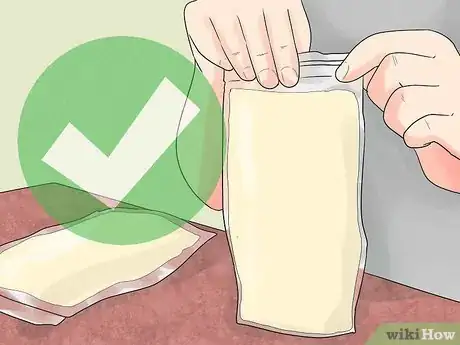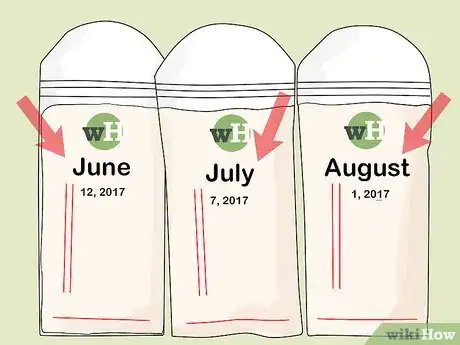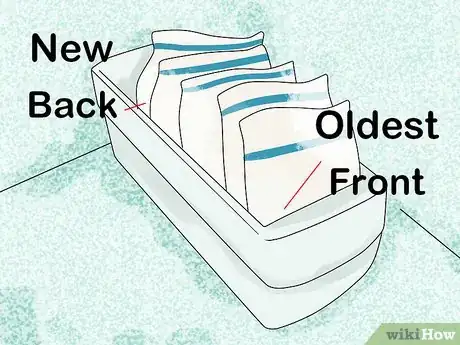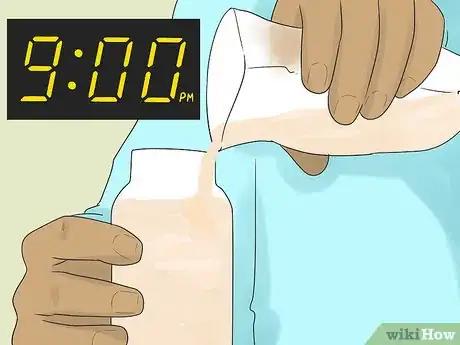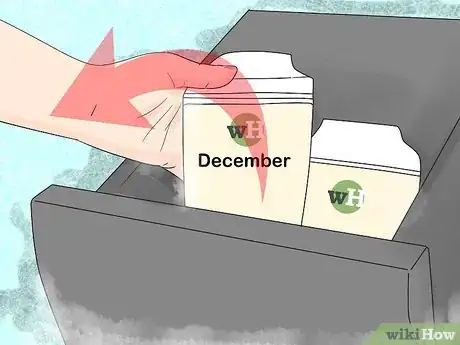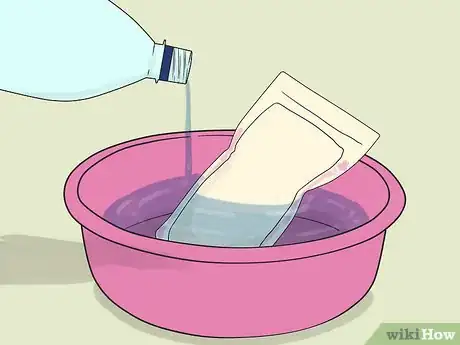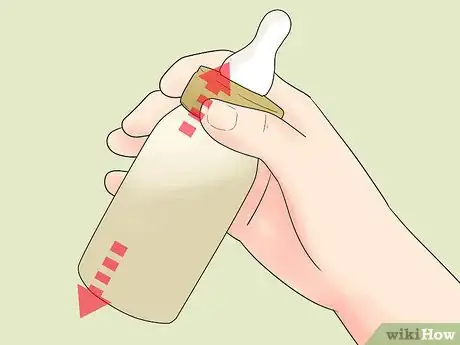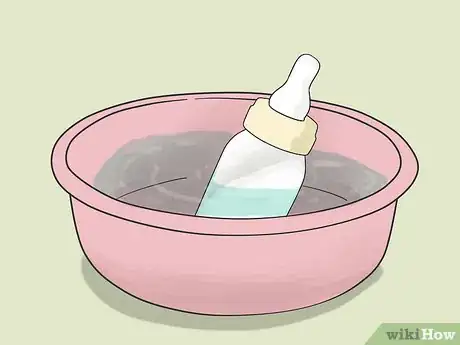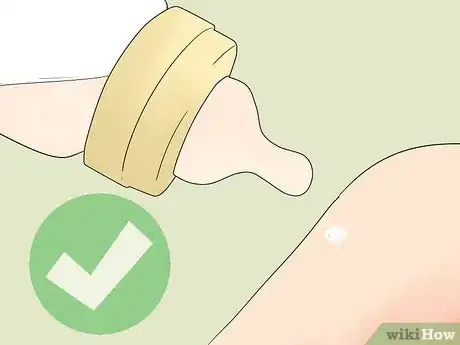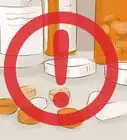This article was medically reviewed by Sarah Gehrke, RN, MS. Sarah Gehrke is a Registered Nurse and Licensed Massage Therapist in Texas. Sarah has over 10 years of experience teaching and practicing phlebotomy and intravenous (IV) therapy using physical, psychological, and emotional support. She received her Massage Therapist License from the Amarillo Massage Therapy Institute in 2008 and a M.S. in Nursing from the University of Phoenix in 2013.
This article has been viewed 111,003 times.
If you are breastfeeding, you might have extra milk stored in the freezer. Thawing it incorrectly can spoil the milk and possibly put your baby in danger. It’s important to thaw your frozen breast milk slowly. You can thaw your milk out overnight or over a couple of hours during the day. If you've prepared your milk ahead of time, you'll keep your baby safe and avoid wasting any frozen milk!
Steps
Freezing Your Milk
-
1Store milk in small portions. Breast milk is only good for about 24 hours after thawing, so don’t freeze more than one day’s worth of milk in a single container. You can store your milk in special freezer bags or freezable bottles--two to four ounces is best for each container.
- If you're using a container, choose a glass or BPA-free plastic container with a tight-fitting lid.
- If you're using bags, avoid using normal storage bags or bottle liners. Choose bags designed for freezing breast milk.
-
2Label milk with the date. Even when frozen, breast milk will not last forever. Don’t use breast milk that has been frozen more than three to six months old. Labeling your milk will help you make sure your baby is getting good milk.[1]Advertisement
-
3Keep the oldest milk in the front of the freezer. Store new milk in the back of the freezer where the temperature is more consistent. This will also help ensure that the first portion you use is always the oldest.[2]
-
4Take milk out to thaw nightly. Make it part of your nightly routine to take the next day’s portion of milk out to thaw. That way you won’t be stuck without milk and you won’t be tempted to thaw the milk too quickly![3]
Thawing Overnight
-
1Take the oldest milk out of the freezer. Check the label to be sure it's not more than a few months old. Make sure there aren’t any older containers hidden in the back of the freezer![4]
-
2Put the milk in the refrigerator overnight. It can sometimes take up to 12 hours for milk to fully thaw in the refrigerator, so make sure you give yourself enough time! If your baby usually feeds at 7:00 AM, the milk should be in the refrigerator no later than 7:00 PM the night before.[5]
-
3Serve the milk in the morning. Make sure the milk is fully thawed before you give it to your baby. If you aren’t able to use it within 24 hours of thawing, don’t risk spoilage--throw it away!
Thawing on the Same Day
-
1Place the frozen milk in warm water. Run the container under a faucet with warm water or put it in a bowl of warm water. After a few minutes, you can replace the room temperature water with warm water until the milk reaches room temperature.
-
2Use a bottle warmer to heat it up. Instead of using warm water, place a bottle with frozen breast milk in a bottle warmer. Turn it on. The bottle warmer will gently thaw the milk. Buy a bottle warmer at a baby store or online.[6]
-
3Serve or put in the refrigerator. If you store the milk in the refrigerator, be sure to use it within 24 hours! You can put on a new date label so you don't forget to use it. Don’t refreeze thawed milk, it can incubate harmful microbes that can be dangerous for your baby.[7]
Using Thawed Breast Milk
-
1Shake or swirl the container gently. Milk can separate and form a layer of fat at the top. Gently shake or swirl the container to mix the two layers together again.[8]
-
2Heat in warm water (optional). If your baby prefers heated milk, place the sealed container in a bowl of warm water until it reaches your baby’s favorite temperature. Never, ever heat milk in a microwave, stovetop, or in boiling water. It can destroy the nutrients in the milk, and it can also scald your baby![9]
-
3Test the milk’s temperature. Before giving the milk to your baby, test its temperature by putting a few drops on your wrist. If it feels hot to you, it’s too hot for your baby! It should feel lukewarm.[10]
- Do not just touch the outside of the bottle to check the temperature, as this can be misleading. Always test it on the skin of your wrist or arm.
-
4Taste or smell the milk. If the milk smells or tastes sour, throw it away. Always check for spoilage, especially if the milk has been at room temperature for more than an hour or in the refrigerator all day.[11]
Warnings
- Do not let thawed milk sit in the refrigerator for more than a day or at room temperature for more than a few hours.⧼thumbs_response⧽
- Do not heat milk in the microwave or on the stove. This can reduce the nutrients in the milk, and milk that is heated too quickly can develop “hot spots” that can burn your baby.⧼thumbs_response⧽
- Never refreeze thawed milk.⧼thumbs_response⧽
- Do not mix fresh and frozen breast milk.⧼thumbs_response⧽
References
- ↑ https://www.cdc.gov/breastfeeding/recommendations/handling_breastmilk.htm
- ↑ https://www.cdc.gov/breastfeeding/recommendations/handling_breastmilk.htm
- ↑ https://www.medela.com/breastfeeding/mums-journey/storing-and-thawing-breast-milk
- ↑ https://www.medela.com/breastfeeding/mums-journey/storing-and-thawing-breast-milk
- ↑ https://www.medela.com/breastfeeding/mums-journey/storing-and-thawing-breast-milk
- ↑ https://www.parents.com/baby/care/american-baby-how-tos/how-to-heat-a-bottle/
- ↑ https://www.womenshealth.gov/breastfeeding/pumping-and-storing-breastmilk
- ↑ https://www.womenshealth.gov/breastfeeding/pumping-and-storing-breastmilk
- ↑ https://medlineplus.gov/ency/patientinstructions/000633.htm
About This Article
To thaw breast milk on the same day, remove it from your freezer and make sure it’s less than 6 months old. Taste and smell it to make sure it’s not sour; if it is, throw it away. If not, place the container in a bowl of warm water for a few minutes, replenishing with more warm water when it cools down, until the milk is at room temperature. If you have more time, thaw the milk by placing it in the refrigerator 12 hours before feeding. Keep it for no more than 24 hours once you start the thawing process, and remember not to refreeze it. If you want to learn how to freeze the breast milk properly, keep reading the article!
